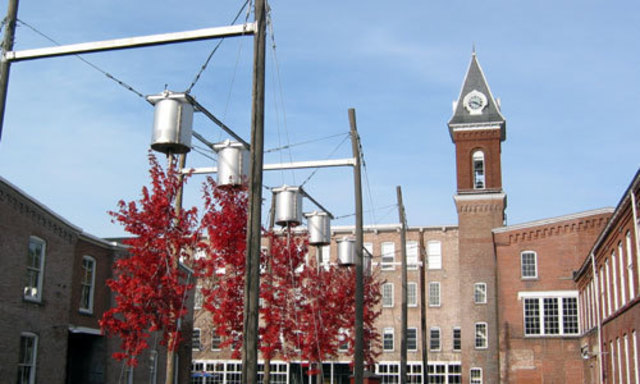
Description
Natalie Jeremijenko is an artist-experimenter. Her projects and those with an artists' collective called the Bureau of Inverse Technology have consisted of creating devices and situations for the purpose of gathering overlooked facts. These data sets and the means by which they were formed range from the Despondency Index (for which the Bureau installed a motion detector camera on the Bay Bridge in San Francisco, recorded suicides, and graphed the relation of suicides to stock market and other data) to Tree Logic (1999) at MASS MoCA (in which six live trees are inverted and suspended from a truss, displaying the contrived growth responses of the trees over time). In this age of the commodification of information, Jeremijenko has made data her medium.
In Tree Logic, the art of the piece is not found in its condition at any single point in time, but in the change of the trees over time. Trees are dynamic natural systems, and Tree Logic reveals this dynamism. The familiar, almost iconic shape of the tree in nature is the result of gravitropic and phototropic responses: the tree grows away from the earth and towards the sun. When inverted, the six trees in this experiment still grow away from earth and towards the sun - so the natural predisposition of trees might well produce the most unnatural shapes over time, raising questions about what the nature of the natural is.
By framing certain phenomena, such as tree growth or suicides, as a data set, Jeremijenko's work illustrates the ability of scientific presentation to transform information. These phenomena are accessible without the artist's intervention, but her presentation of them allows the viewer to examine and question them in new ways. (In this sense, her inverted trees may be compared to Marcel Duchamp's Fountain, actually an inverted urinal, of 1917.) Our perceptions of trees change when we view them as a collection of growth responses rather than as immutable symbols of the natural world. The public for a work of art, and for Tree Logic in particular, is encouraged to interpret (and debate) motives and outcomes, though the opposite is often true of "real" science, which does not invite public discourse. Through her elaborate framing systems (in this case a metal armature, stainless steel planters, and telephone poles), Jeremijenko revels in exposing the idiosyncratic manipulation intrinsic to combining facts to form data.
Details
- Work Date:
- 1999
- Credit Line:
- Supported by the Sterling & Francine Clark Art Institute and the Massachusetts Cultural Council.